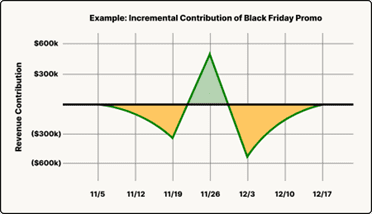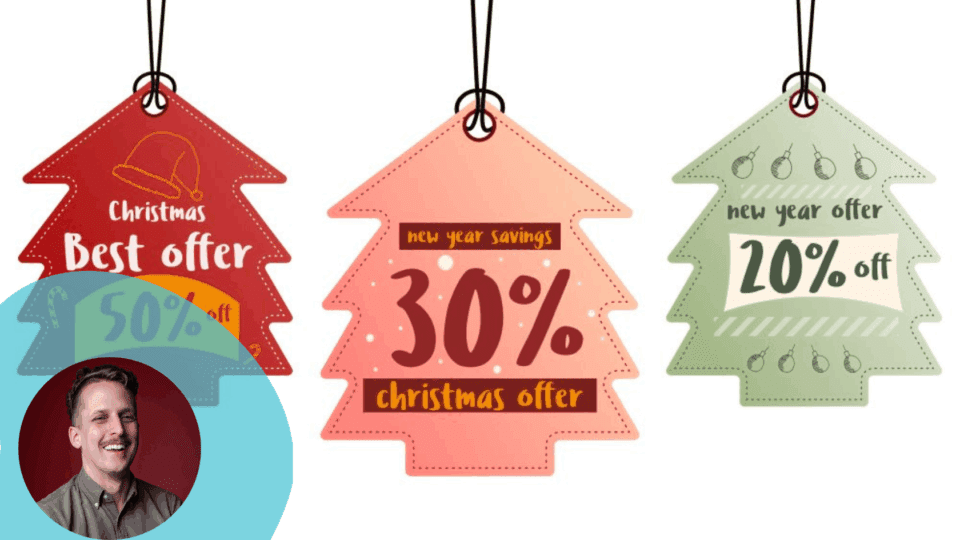Every holiday season, we hear the buzz of internal celebrations, “Company XYZ Celebrates Record Black Friday!” Carts are full, conversion rates are up and execs breathe sighs of relief.
But when the dust settles, the numbers tell a different story: Q4 profit was down YoY, margins plummeted and Q1 sales have started off soft.
What happened?
This is the promotion paradox: retailers celebrating record-breaking sales days while actually losing money. The root cause is failing to measure the incremental impact of promotions. Those Black Friday “extra” sales? Many of them would have happened anyway at full price. Instead, deep discounts simply shifted existing demand into a narrow window, eroding margins rather than growing the business.
I’ve seen retailers transform this dynamic, turning promotions into genuine profit drivers. Here’s how you can do the same.
Understanding “Pull-Forward” and “Pull-Backward” Effects
The first and biggest issue with promotional events isn’t that they don’t drive sales. It’s that they risk shifting the timing of sales that would have happened anyway.
In the weeks leading up to Black Friday, for example, customers regularly delay their purchases as they wait for better deals. This push-backward effect, as I like to call it, leads to steep revenue drop-offs in early November. Then, after the big promotion period, these same customers might stop buying altogether, leading to a pull-forward effect that flattens sales in December and January. These phenomena can be especially true for brands that have created the expectation of steep BFCM discounts every year.

I see this play out every year across the retail space, where many brands experience the holiday season as an extended promotional blur. As industry insiders have pointed out, discounts that once lasted a weekend now span nearly two weeks, often just to meet platform demands like Amazon’s 12-day BFCM window. This forces smaller brands to choose between volume and viability, as discounts beyond 30% off can quickly become unprofitable in lower-margin categories like beauty.
There are circumstances where the spikes in revenue during promo periods are great and profitable for brands. But there are others where they mask considerable issues. I’ve seen brands run multiple discounts per year whose incremental revenue contribution was in the negative seven figures – each!
How does this happen? Imagine offering a 40% discount to loyal customers, 95% of whom would purchase your product at some point in Q4 regardless of its price. With the promotion, you’re merely paying a tax on demand you’ve already built for your business. Multiply this across categories, and it’s no wonder retail profits often suffer despite banner revenue months.
Rethinking Traditional Retail Measurement
A more subtle driver of the promotion paradox is measurement. Many retail marketing analytics teams look at the wrong metrics with the wrong temporal scope. They focus on YoY comparisons of topline revenue, conversion rates, AOV and attribution metrics, instead of zooming out and considering whether any of these sales were incremental for their business.
Remember, promotions – particularly when they’re routine and expected – can dramatically shift demand. This means that comparing metrics for the same calendar week across years ignores whether sales were moved from October, December or even Q1 of the following year.
Worse, while platform-reported metrics like ROAS or attributed conversions tell you what happened, they can’t capture if sales were incremental. In other words, they can tell you that your ads were touched along the path to purchase, but can’t tell you whether those purchases would have happened anyway without an ad or promotional intervention.
Without this clear view of causality (which sales would not have happened without a marketing intervention), teams will keep celebrating spikes that are actually cannibalizing future growth.
Solving the Promotion Paradox with Intentional Measurement
To avoid these pitfalls, retailers can start by asking better questions about promotion planning:
- What would we expect sales to be without this promotion?
- Are we creating new demand, or simply shifting it?
- What’s the true incremental profit impact of the promo (not just revenue)?
- Are discount-driven customers worth less over time than full-price ones?
To begin answering these questions, it’s important to use tools intentionally to measure the true impact of your promotions. Here are some strategies that I’ve seen deliver results:
- Holdout testing: Leave select stores, regions or customer groups at regular price to establish a baseline.
- A/B discount testing: Run 20% vs. 30% off tests to understand where diminishing returns kick in.
- Longer-window analysis: Track performance eight weeks before and after major promotions to detect demand shifts.
- Customer cohort analysis: Compare long-term value of customers acquired via deep discounts vs full-price or light-promos.
- Econometric modeling: Some tools like modern media mix models (MMMs) can isolate the incremental impact of advertising and promos, while accounting for seasonality.
Crafting a Holiday Measurement Plan for 2025
This year, retailers looking to get a head start on the holiday season should craft measurement plans that treat promotions as long-term strategic investments. This might mean:
- Testing smaller, category-specific offers instead of sitewide discounts
- Running “no promo” experiments in high-margin categories
- Spreading demand more evenly across Q4 to avoid fulfillment and staffing crunches
- Building marketing calendars that factor in demand lag, seasonality and customer fatigue
Offering promotions is still an important retail strategy, just so long as retailers stop treating revenue spikes as proof of success. The key is to pair every major promotion with a robust measurement plan: What are we testing? How will we track incrementality? And how will we leverage what we learn moving forward?
With smarter promotions and smarter measurement, you can stop paying a premium to pull your demand forward – and start Q4 off on the right foot.
Michael Kaminsky, CEO of Recast, is a trained econometrician with a background in healthcare and environmental economics. He previously built the marketing science team at men’s grooming brand Harry’s before co-founding Recast.




